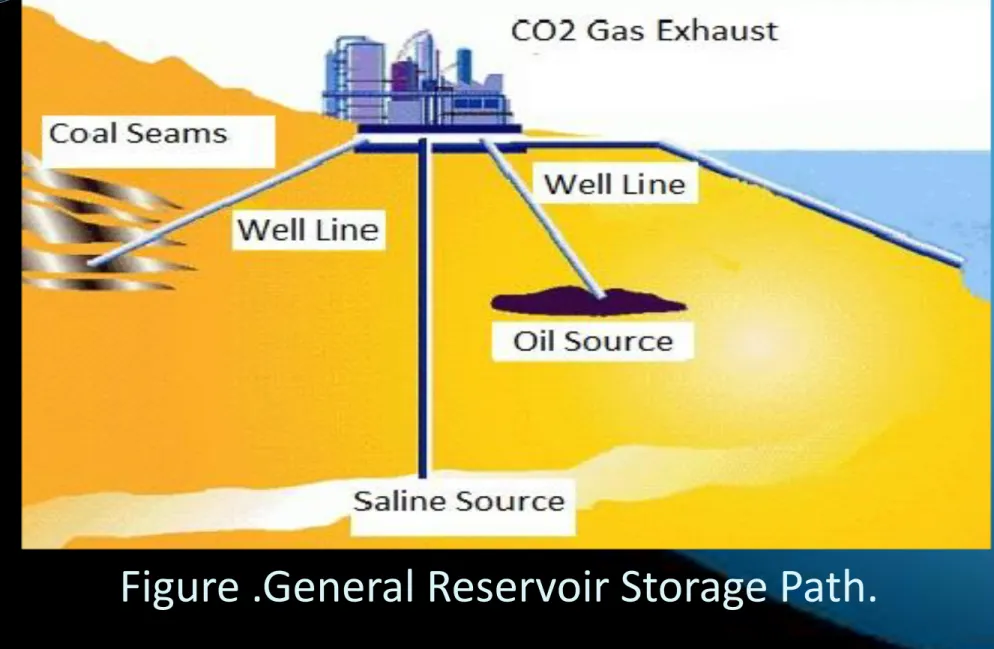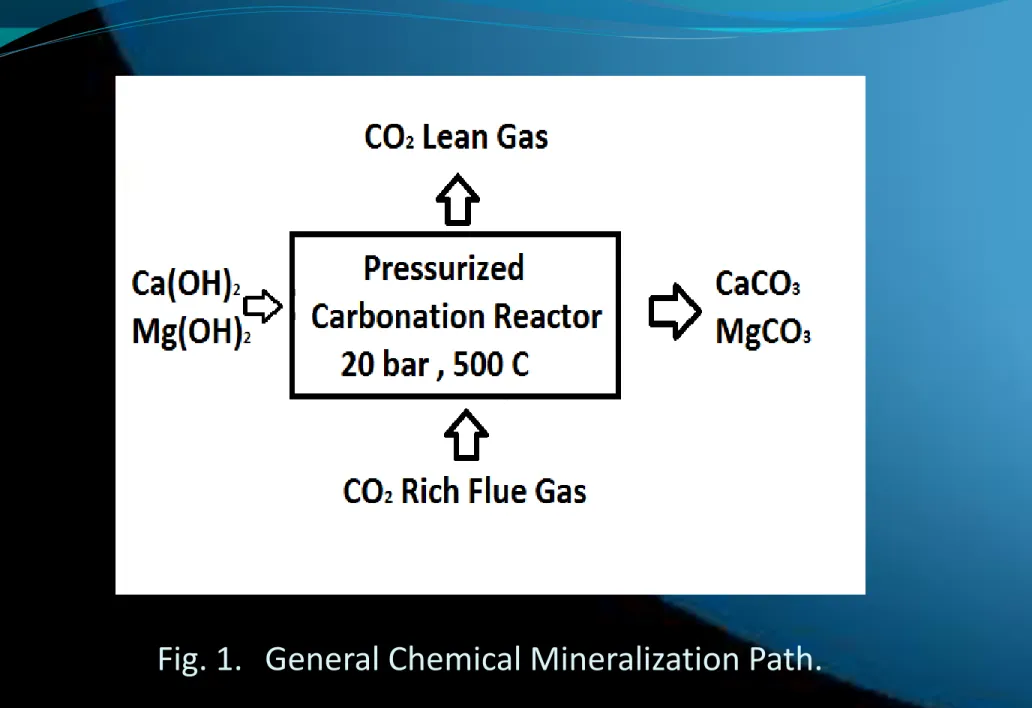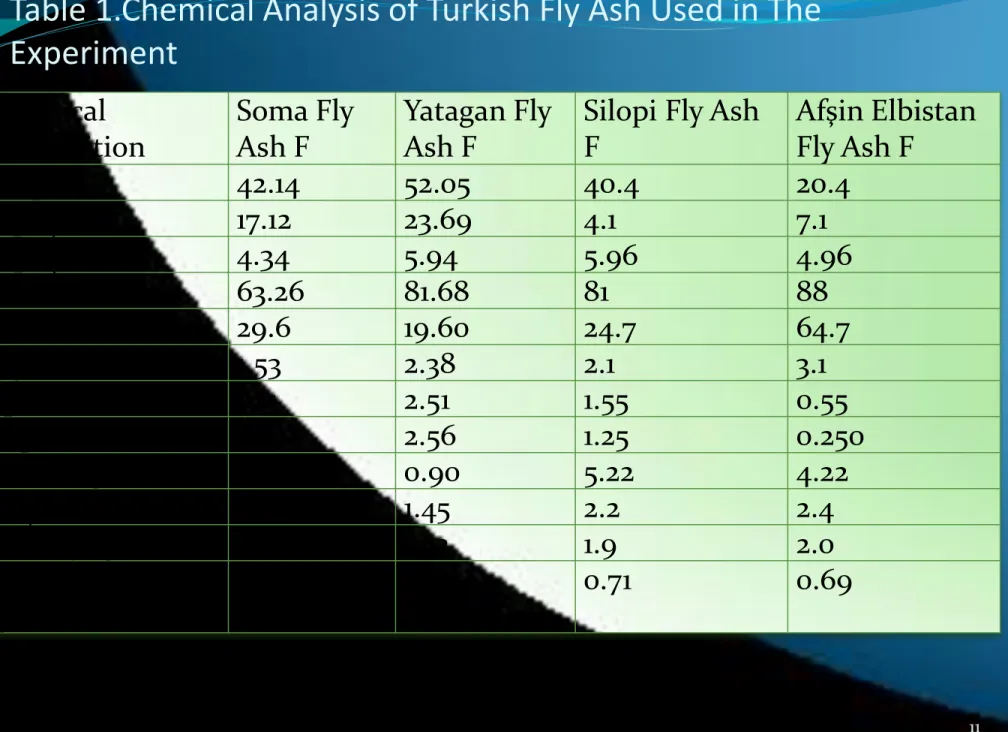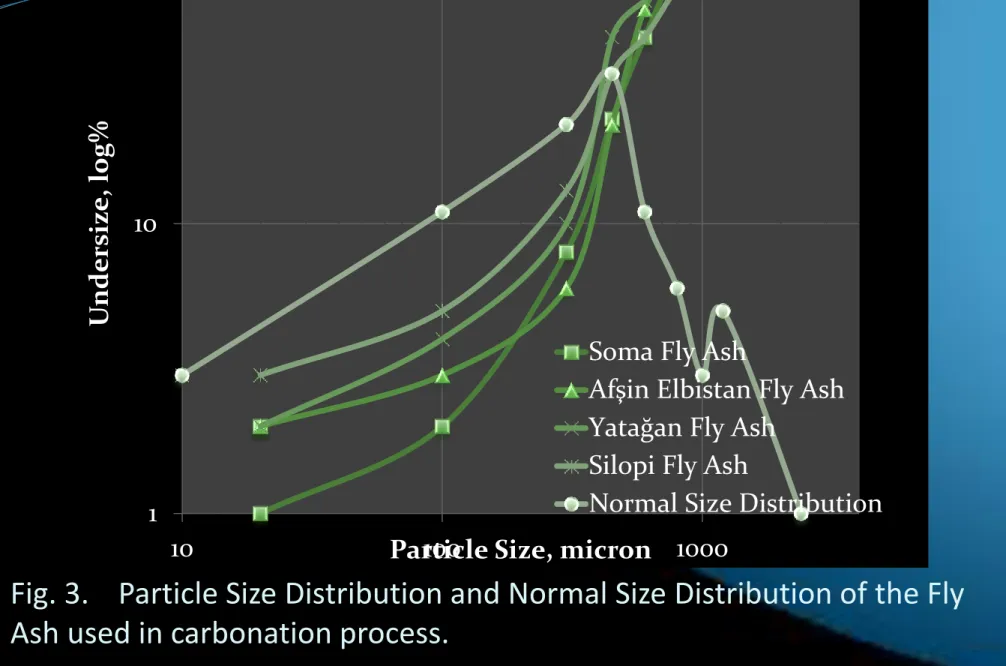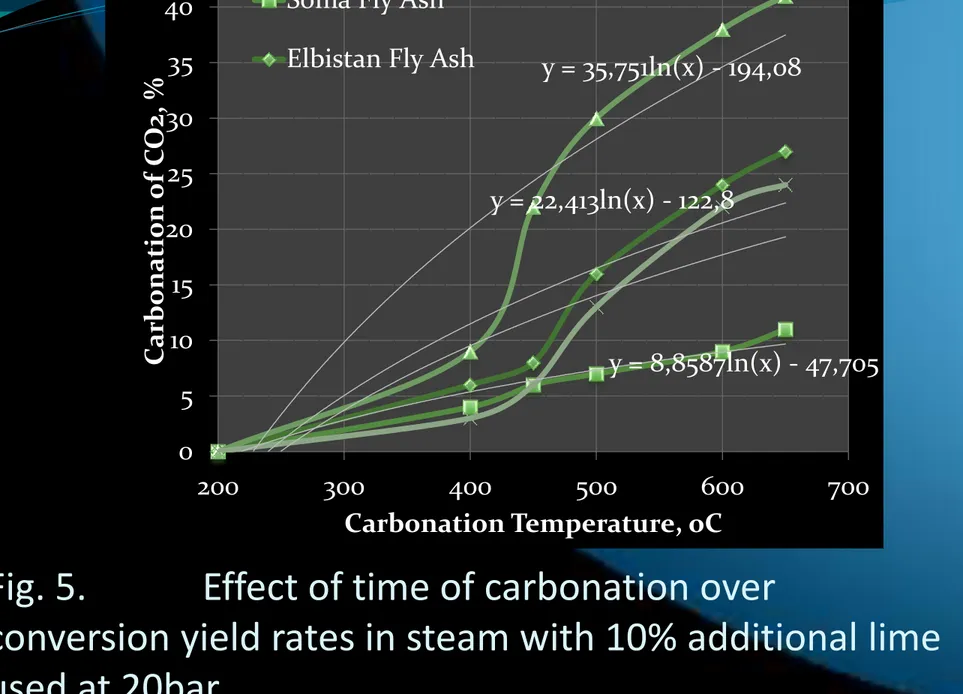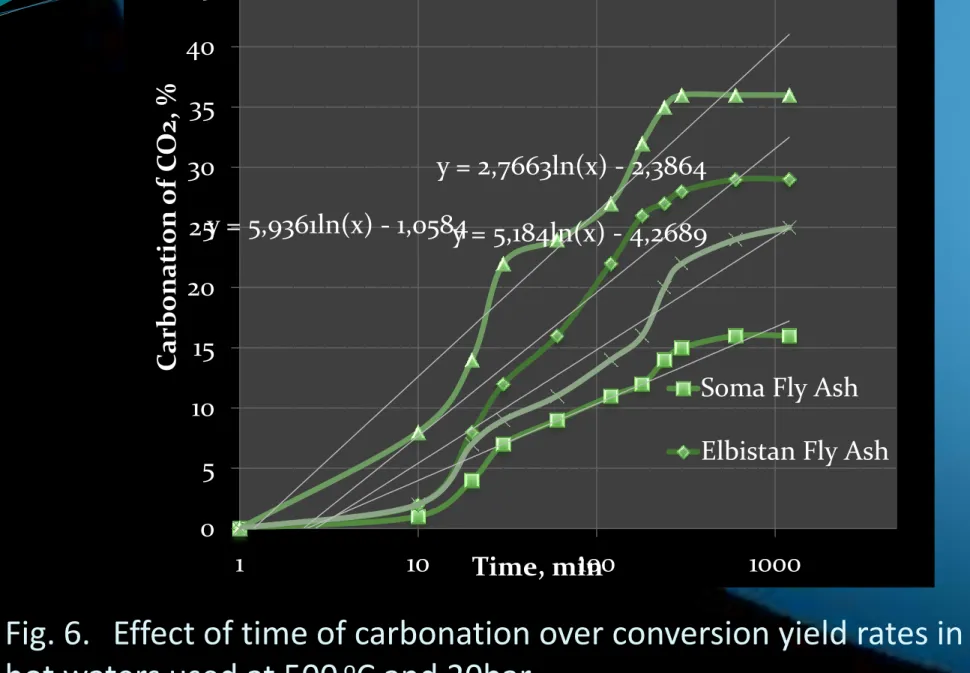Yıldırım İ. Tosun
Engineering Faculty, Şırnak University, Sırnak
*
Corresponding Author. Tel: +90(544) 5896824, Fax:
(486) 2164844, E-mail:
yildirimtosun@sirnak.edu.tr
Aim
Sequestration industries with economically
competitive and environmentally conscious
technology options to produce electricity,
The Sequestration process for Flue Gas of Sırnak
asphaltite
The production of carbonates in cost and energy
Scope
Depending on the combustion technology, lignite coal ash contains 10–25% free reactive lime. CO2 capturing, transport and sequestration by pressurized water dissolution and reacting by natural alkali lime and magnesia in coal fly ash or other sources becomes an industrial advantageous sequestration option resulting in green waste solutions or solid fines. Reactive Mg and Ca containing ash is sufficiently reacting with flue gas CO2 to form the carbonates. Various types of fly ash materials may react with CO2 to form carbonate regarding the fly ash composition and reaction parameters. Carbonation of CO2 will also allow us to produce fine raw materials for cement production industry or as cement filling material in constructions with low cost.
In this study, the fly ash contains 10–25% free lime of Soma, Yatagan, Afşin Elbistanand Silopi Power Stations were received and transported to wet open-air ponds, by a hydraulic system. Main work used 100,0–200,0 cubic meters of ponds with full of slurry fly ash. This slurry will contain Ca2+-ion-saturated alkaline water (pH level 12–13) and easily
recycling between the plant and sedimentation ponds.
This study discussed the results of tests in that the progress on three consecutive column reactors carbonation achieved and search for fast reaction methods using coal fly ash of Soma, Yatagan, Afşin Elbistan and Silopi Power Stations. Other ash materials containing magnesium and magnesium silicates, supercritical CO2, steam- slurry, and additives were searched for pretreatment methods to enhance mineral reactivity; and in analyzing the structural changes to identify reaction paths and potential barriers.
Introduction
Carbonation of CO2 gas has many various advantages. Most distinct fact is that carbonates have a lower energy
state than CO2. Mineral carbonation is thermodynamically occurs in nature (i.e., the weathering of rock over
geologic time periods). Further, the raw materials such as magnesium based minerals are abundant on earth.
The produced carbonates are basely stable and thus re-evolve of CO2 into the atmosphere is not an issue.
However, conventional carbonation reactions are slow under ambient temperatures and pressures.
Forty percent of global electricity is generated in fossil fuel power plants per annum, with emissions of about
33% (9.5 billion metric tons) of global energy related CO2 emissions of approximately 28.8 Gt in 2010
(Minchener and McMullan, 2007, IEA, 2012). Over half of the electricity demand of the Turkey is supplied by
coal-fired power plants, with emissions of about 16 million metric tons of CO2 per annum, representing about
33% of Turkey energy-related CO2 emissions (TKI, 2009, TTK, 2009).
Therefore, developing effective CO2 sequestration is one of the critical components in addressing global
climate change. Note that improving the efficiency of energy production and utilization, and developing
renewable energy sources will certainly play a very important role in reducing CO2 emissions (5), however
these measures alone cannot address the greenhouse emissions issue mainly because world energy consumption will increase significantly as the living standard improves in many parts of the world.
Three boreholes, one injection well, and two observation wells will be drilled, about 50 – 100 m (160 – 330 ft)
apart, into the flank of an anticlinal structure. A total of up to 1 t/day of CO2, in gaseous state at the well head,
will be injected at about 700 m (2300 ft) depth into a saline mudstone aquifer. Injection is planned to start at the end of 2013 and last for approximately 2 yr, during which the distribution and fate of the injected gas will be monitored by surface geophysical surveys and by downhole instrumentation. Various processes and
subprojects and work packages address the science and operational aspects of CO2 (IPCC, 2005, Stangeland,
2007, Solomon, 2006, Torp and Gale, 2004, Siegenthaler and Oeschger,1987, Keeling et al., 1995,
Plasynski,1996). The proposed part of the project is restricted to the baseline survey and the injection and
basic monitoring of CO2. The supply of CO2 will be provided by near Coal Power Station in Şırnak. Other
choice will be the purchase of a pure CO2 originating from flue gas of hydrocarbon production at an oil
refinery. The CO2 will be delivered by truck in liquid phase, temporarily stored at the well site, and
conditioned before injection. The project proposed plans to inject the CO2 at the well head in gaseous phase
at a slightly supercritical pressure and slightly supercritical temperature. The anticline at Şirnak -Silopi was used for gas storage in the past in a shallower depth interval in Şırnak-Silopi pit mine field, which also is an
Options for storing CO2 in deep underground geological formations need adequate porosity and thickness for storage capacity and permeability for gas injection are critical. The storage formation should be capped by extensive confining units such as shale, salt caves or anhydrite beds to ensure that CO2 does not escape into overlying, shallower rock units and ultimately to the surface. Geological storage of CO2 requires compression of CO2 to allow
injection. This is done by compressing the CO2 to a dense fluid state known as ‘supercritical’. This supercritical state is achieved by exposing the CO2 to
temperatures higher than 31.1oC and pressure greater than 73.9 bars. The density of CO2 will increase with depth, until about 800 meters or greater, where the injected CO2 will be in a dense supercritical state (DOE , 1998, Simbeck, 2004, Burruss, 2004, Oldenburg et al., 2001)
The mineral carbonation, a process of converting CO2 into stable minerals - mineralization has been studied extensively to capture and store CO2 (Stevens et al., 2001). The flue gas treated by fly ash particles, even mineralization hold high mercury (Hg) concentration of 0.22 mg/kg in flue gas (Myer, 2003, Zweigel et al., 2001).
Geothermal brine waters utilization and using CO2 as feed material in mineral carbonation produce various environmentally benign products.
Mineral sequestration involves the reaction of CO2 with minerals to form geologically stable carbonates. This mineralization of CO2 was searched by different studies using various materials (Lindeberg, 2003, Rubin and Rao, 2003). General and specific global mineral carbonation reaction pathway is shown in Figure 1. The goals of the current work were to design an ash–water suspension carbonation process in a continuous mode laboratory-scale plant and to search for potential means of intensifying the water neutralization process (Davis, 2004, Seifritz, 1990, Kojima et al., 1997, Gunter et al. 1993, Lackner et
al.,1995). The carbonation process was optimized by cascading columns in which the pH progressed from alkaline to almost neutral. The
amount of CO2 captured from flue gases can reach 0,01–0,12 kg/l at the 500oC temperature and 10 bar pressure level (O’Connor, 1998).
Laboratory-scale neutralization experiments were carried out to
compare the reactor designs. Sedimentation of carbonate particles was observed and their main characteristics were determined.
METHOD OF MINERAL
SEQUESTRATION
Mineral sequestration involves the reaction of CO2 with minerals to form geologically stable carbonates. This mineralization of CO2 was searched by different studies using various materials(Davis, 2004, Seifritz, 1990, Kojima et al., 1997, Gunter et al. 1993, Lackner et al.,1995). General and specific global mineral carbonation reaction pathway is given below the reactions.
Mineral carbonation reactions are known to geologists and occur
spontaneously on geological time scales. For example, the reaction of CO2 with common mineral silicates to form carbonates like calcite and magnesite or
calcite is exothermic and thermodynamically favored.
The family of reactions represented by Reaction 1 has the potential to convert naturally occurring silicate minerals to geologically stable carbonate minerals and silica (O’Connor, 1998). This process follows natural chemical
transformations such as weathering of rocks to form carbonates over geologic time periods. Reaction 2 illustrates the transformation of the common silicate mineral serpentine (Goldberg et al., 2000), Mg3Si2O5(OH)4, and CO2 into
magnesite, MgCO3, silica and water (O’Connor, 1998, Butt et al.,1997,
Drägulescu et al., 1977). Using this ideal case, one ton of serpentine can dispose of approximately one-half ton of CO2 (Goff et al., 1997).
Fig. 1. General Chemical Mineralization Path.
Fig. 2. Chemical Reaction Process of fly ashes for sequestration in the
Diagram.
Table 1.Chemical Analysis of Turkish Fly Ash Used in The
Experiment
.
Chemical composition Soma Fly Ash F Yatagan Fly Ash FSilopi Fly Ash F Afşin Elbistan Fly Ash F SiO2 (S) 42.14 52.05 40.4 20.4 Al2O3 (A) 17.12 23.69 4.1 7.1 Fe2O3(F) 4.34 5.94 5.96 4.96 CS+CAF 63.26 81.68 81 88 CaO 29.6 19.60 24.7 64.7 MgO 1.53 2.38 2.1 3.1 K2O 1.15 2.51 1.55 0.55 Na2O 1.29 2.56 1.25 0.250 Loss of ignition 0.34 0.90 5.22 4.22 SO3 3.43 1.45 2.2 2.4 Density (g/cm3) 2.22 2.12 1.9 2.0
Loose unit weight (g/cm3)
Table. 1.Chemical Analysis of Turkish Geothermal Hot Waters
Chemicalcompositi on, mg/lt
Well 1 Well 2 Well 3 Well st Well ht
Ca2+ 55 222 20 953 1760 Fe2+ 17.12 23.69 7.1 0.2 0.5 K+ 6.3 7.9 5.9 102 430 Mg2+ 10.26 33.68 8.0 289 1310 Mn2+ 0.6 0. 02 - 0.01 0.01 Na+ 15 238 365 16785 90100 F- 0.35 0.51 0.55 - - Cl- 19 122 250 27440 114300 NO3- 1.34 90 0.92 - - SO42- 13.43 145 14 1134 3547 HCO3- 210 502 510 184 40 pH 8,3 8,6 8,4 9,1 9,3
Fig. 3. Particle Size Distribution and Normal Size Distribution of the Fly
Ash used in carbonation process.
13 1 10 100 10 100 1000 U ndersiz e, log%
Particle Size, micron
Soma Fly Ash
Afşin Elbistan Fly Ash Yatağan Fly Ash
Silopi Fly Ash
The major technical challenge now hindering the use of
minerals to sequester CO
2is theirs low reaction rate.
Weathering of rock is extremely slow. The highest priority is
given to identifying faster reaction pathways. The optimized
process has to be economical. Although many carbonation
reactions are exothermic, it is generally very difficult to recover
the low-grade heat while the long reaction time and
Fig. 4.
Effect of carbonation time over conversion
yield rates in hot 500
oC steam used.
y = 4,0593ln(x) - 2,8345 y = 8,4446ln(x) - 5,392 y = 9,3085ln(x) - 4,8078 0 5 10 15 20 25 30 35 0 10 20 30 40 50 Car bona tion of C O2, %
Carbonation Pressure, bar
Soma Fly Ash Elbistan Fly Ash Yatağan Fly Ash Silopi Fly Ash
Fig. 5.
Effect of time of carbonation over
conversion yield rates in steam with 10% additional lime
used at 20bar .
16 y = 8,8587ln(x) - 47,705 y = 22,413ln(x) - 122,8 y = 35,751ln(x) - 194,08 0 5 10 15 20 25 30 35 40 45 200 300 400 500 600 700 Car bona tion of C O2, % Carbonation Temperature, oCSoma Fly Ash Elbistan Fly Ash
Fig. 6. Effect of time of carbonation over conversion yield rates in
hot waters used at 500
oC and 20bar.
y = 2,7663ln(x) - 2,3864 y = 5,184ln(x) - 4,2689 y = 5,9361ln(x) - 1,0584 0 5 10 15 20 25 30 35 40 45 50 1 10 100 1000 Car bona tion of C O2, % Time, min
Soma Fly Ash Elbistan Fly Ash
The environmental impact from mining, mineralization and carbonation processes must be considered in sequestration. We succeeded in achieving shortened carbonation reaction times employing fly ash containing lime and calcium magnesium silicates such as gehlenite, mehlenite. Reaction took 4 hours to reach 40-50% completion of carbonation. The reaction required temperatures of 450-550oC, pressures of 10-20 bar, and mineral particles in the -100 micron
size range. Because the high pressure requirement of the carbonation reaction will certainly lead to high process costs, the team is modifying solution chemistry to allow reaction to proceed at a lower pressure and temperature. The research showed that the concentration of HCO3- in
the solution is critical to the reaction rate. The high CO2 pressure will lead increased CO2 absorption in the solution and thus enhance the HCO3- concentration. Adding bicarbonate such as sodium bicarbonate
in the solution will significantly increase the HCO3- concentration even
In experiments with 3 hours reaction period at reactor
temperature of 500
oC and fly ash slurries were kept under
changing CO
2pressure ranged 5 bar to 40 bar. Products
were
subjected
to
analysis
for
carbonate
yield
determination. Test results of yields for different Turkish fly
ash sources were seen in Fig. 4.
That quantity in the carbonation amounts were determined
for different source evaluation and reduce the effect of gas
content of waste gas in order to optimize carbonation rates.
As given in Fig. 4 gas conversion yield for steam and ash
samples were greatly differed. Yatağan and Elbistan Fly ash
showed high carbnation yields reaching 32% and 30%
respectively. Beause of active lime amounts were over 20%
and even alkali Na and K contents were over totally over
5%, the higher carbonation yields were sufficiently
provided by three consecutive carbonation columns at 20
bar.
In the carbonation experiments with addition alkali,
reactor temperature changed between 200
oC and 650
oC
and ash slurries were mixed with active lime additionally by
%10 rate. Products received from carbonation of ash
specimens were subjected to analysis for gas hold-up
determination. Test results of carbonation by fly ash and
also alkali lime contained over active lime at 10% weight
rate were investigated.
In experiments with 3 hours reaction period of ash
specimens, at reactor temperature changed between 200
oC
and 600
oC and all ash samples contained over active lime at
10% weight rate. Products were subjected to analysis for
carbonate yield determination. Test results of carbonation
yields of Turkish fly ash sources and additional 10% lime
were seen in Fig. 5.
The qualitative comparison of the carbonation for three different
Turkish fly ash reactants and products revealed a complete MgO,
CaO– MgO to Mg CO
3-CaCO
3conversion. The carbonation
efficiency of CaO was dependent on the initial pressure of CO
2of
20bar. This was significantly affected by reaction temperature
500 °C and by the fly ash dose 100 gr/l. The kinetic data
demonstrated that the initial rate of CO
2transfer was enhanced
by carbonation process for our experiments. The precipitate
calcium carbonate was characterized by isolated micron sized
particles and micron agglomerates of calcite.
This study reveals suitable large scale operating units in order to
achieve the carbonation method as a viable sequestration tool at
industrially relevant scales by using Turkish fly ashes in 500-600
o
C waters. Carbonation liquid and gaseous products may change
to near 20%–40% yield performances by time increase from 1hr
to 6hr.
While there is a potential to utilize other types of flue ashes in mineralization, lime or similar alkali can be evaluated to sequester CO2 allowing clearly significant amounts. Even there are researches succeeded usage of serpentine and olivine. Consequently, the flue gas should be continuously monitored to measure flue gas flow at depleted gas outlet in order to reprocess it.
Carbonation of the ash slurries and carbonation yield products changed to 37%, 29%, 25% and 19%for Yatağan, Elbistan, Silopi and Soma Fly ash, respectively, by time increase from 1hr to 6 hr.
Other harmful emissions caused by flue gas containing high sulfur (S), and mercury (Hg) content can be eliminated by this method. In that study, results suggested that an appreciable amount of flue gas CO2 and significant amounts of SO2 and Hg can be directly captured and mineralized by the fly ash particles.
Even with progress made so far, to develop an economical method to sequester CO2 with minerals is still a challenging task, because the process is still relatively slow, and most reactions require high pressure and moderately elevated temperature.
